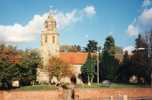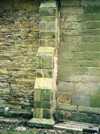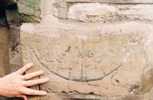 Keyworth Keyworth
St Mary Magdalene
Stonework
With the exception of a modern brick vestry to the north of the chancel, Keyworth
church is built of stone with a tiled roof. Two kinds of stone predominate:
1 Most
of the nave, chancel and aisles are of local Blue Lias limestone, of which
some is thinly laminated and flaky, while some is more robust in appearance,
with massive blocks two feet long and over six inches thick. The precise source
is unknown; there are no nearby quarries or pits in the Blue Lias still visible,
and any replacements have to be brought from a quarry of similar stone in Somerset. Most
of the nave, chancel and aisles are of local Blue Lias limestone, of which
some is thinly laminated and flaky, while some is more robust in appearance,
with massive blocks two feet long and over six inches thick. The precise source
is unknown; there are no nearby quarries or pits in the Blue Lias still visible,
and any replacements have to be brought from a quarry of similar stone in Somerset.
2The tower and south porch
are made of Triassic sandstone, probably from a quarry near Castle Donington.
It is more uniformly strong than the Blue Lias, and therefore more able to
bear the greater weight of the tower. It has also been dressed to give the
finished appearance of ashlar, appropriate to the most prominent part of the
building. A distinctive feature of this stone is the patterning produced by
compression as the sediment was being laid down, a process known as soft sediment
deformation. A second kind of Triassic sandstone, a much softer and finer pale
reddish stone, is found in some of the window moulding and tracery.
Other stone to be found includes:
3Magnesian limestone, a
sandy limestone used in the mouldings around the windows and porch entrance,
and also in the mullions and tracery of the windows. It was probably obtained
from near Mansfield.
4Carboniferous sandstone
in much of the repair work on the mouldings, undertaken in the 1870s (chancel
and nave) and tower (1927/8). This is a hard material, relatively recently
cut and distinguished by its smooth surfaces and sharp edges. It was probably
obtained from near the Notts/Derbys border.
5Small quantities of Oolitic
limestone (Middle Jurassic from Ancaster, Lincolnshire) and glacial erratics
(from local boulder clay) to fill gaps left by the degrading of individual
blocks in the church walls.
 Two
features of interest on the exterior south wall of the nave are a sundial in
badly worn sandstone, and some deep grooves in the adjoining sandstone window
ledge, said to be the result of its frequent use for sharpening arrows, spears,
knives and swords. Two
features of interest on the exterior south wall of the nave are a sundial in
badly worn sandstone, and some deep grooves in the adjoining sandstone window
ledge, said to be the result of its frequent use for sharpening arrows, spears,
knives and swords.
|